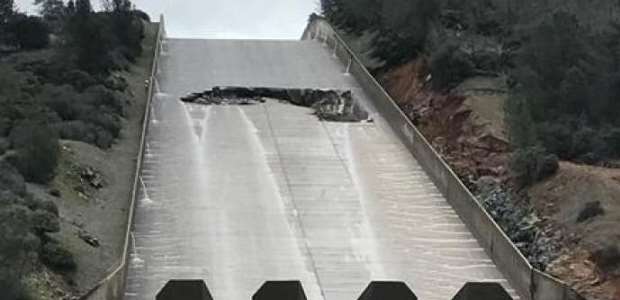
Heavy Rains Filling California's Reservoirs
Releases from the Oroville Dam north of Sacramento were halted by the state Department of Water Resources after a large sinkhole formed in the dam's spillway during the release of 55,000 cubic feet per second of water.
Too much of a good, much-needed thing for the state of California – rainfall – continues to cause problems for some of the state's reservoirs. Rain has filled many of them to near capacity, the San Francisco Chronicle and other newspapers reported Feb. 8, and a sinkhole that opened up in the spillway of Lake Oroville, which is California's second-largest reservoir about 75 miles north of Sacramento, has grown.
The California Department of Water Resources was releasing about 55,000 cubic feet per second (cfs) from the lake through the spillway at the time the sinkhole developed. (Another 5,000 cfs was being released through a power plant at the dam.) The agency said in a news release that its employees "noticed an unusual flow pattern and erosion on the spillway, and they are investigating."
But the agency is removing trees and debris from the corridor near the dam where water would flow if an emergency spillway is needed for the first time in the dam's 48-year history, and that possibility is now likely -- the reservoir reached 90 percent of capacity and an elevation of 880 feet on Feb. 9, holding about 3.22 million acre-feet of water, with inflows having increased to about 118,000 cfs.
The emergency spillway would have no gates, and water would flow down it if the reservoir reaches its capacity of 3.5 million acre-feet at 901 feet elevation. (The reservoir came within 1 foot of overflowing in January 1997, according to the agency.)
The lake was about 80 percent full two days earlier and at that time had sufficient capacity to capture projected inflows for at least three days, DWR said.
At federally run Shasta Lake, which is the state's largest reservoir, more than 1.25 million acre-feet of water was released last month, the largest amount in any January in the past decade, at least, the Chronicle reported, and the federal Bureau of Reclamation raised releases there from 26,000 to 36,000 cfs this week to meet flood space regulatory requirements.
The Oroville Dam is the tallest dam in the United States at 770 feet high – 44 feet taller than Hoover Dam – and measures 6,920 feet across.